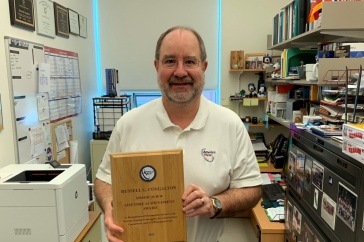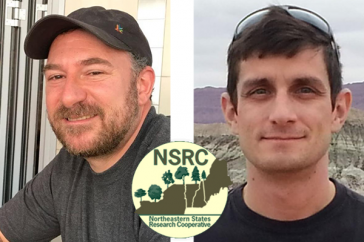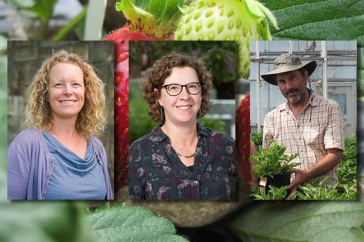
Credit: Chicago Council on Global Affairs
New Hampshire Agricultural Experiment Station scientist Radhika Bartaula, a doctoral student in genetics in the UNH College of Life Sciences and Agriculture, recently attended the Basic Wheat Improvement Course at the International Maize and Wheat Improvement Center (CIMMYT by its Spanish acronym). Learn more about her inspiring story that brought her from Nepal to the University of New Hampshire in Durham to study stem rust, one of the most feared agricultural diseases in the world. Story courtesy of the Chicago Council on Global Affairs blog Global Food for Thought.
In today’s Golden Age of agricultural science and technology, we hear about major breakthroughs that would have felt like magic only half a century ago: genetically modified organisms, crop-monitoring drones, CRISPR/Cas9 (which can edit our own DNA!), robots that weed, remote-controlled tractors, and many more. We have seen remarkable technological advancements in agriculture in many places in the world, resulting in increased productivity and improved food safety. Yet still millions of people suffer from hunger and billions are struggling with malnutrition. There lies an enormous task before all of us to make these awesome technologies deliver food security and nutrition for all.
I have always been drawn to agriculture because I was born into a farming family in rural Nepal. Agriculture is my family’s main occupation and chief source of income. Farming has had great personal meaning to me since my childhood. Seeing how my family, as well as many others, struggled with uncertain income from our harvests and the numerous forms of insecurity that brings, I always dreamed of how I might empower resource-poor farming communities in developing nations. To equip myself for this work, I decided to study agriculture science for my undergraduate degree. My parents were sad that I chose agriculture instead of engineering or medicine. They were worried that I was going to turn out to be a farmer like them, and they wanted much more for me. But I think they later realized that there is so much more to agricultural studies than farming. So I obtained B.Sc. in Agriculture from Tribhuwan University in Nepal. My interest in plant breeding and genetics started when I was exposed to the historic contributions and broad potential of genetics in agriculture. Inspired in particular by the life and work of Dr. Norman Borlaug, I became passionate about the role that plant breeding has played and will continue to play in feeding our ever-increasing human population and fulfilling their other needs in the 21st century.
After completing my undergraduate degree, I worked for two years as a research assistant at the Nepal Agriculture Research Council (NARC) in the wheat breeding unit under Dr. Dhruba B. Thapa, whose research focuses on the improvement and dissemination of rust resistant wheat varieties. It was here at NARC that I learned about the many diseases of wheat and was amazed, and terrified, at how devastating they can be. I realized if one disease alone such as stem rust could cause catastrophic crop losses across millions of hectares of farmland, what could all of these diseases do at the same time without the diligent work of plant breeders to stop epidemics in their tracks? Global food security really does rest on these scientists’ work, even though most people don’t even realize plant breeders exist!
My dream to become an agricultural scientist began to acquire more substance when I got an assistantship to pursue my doctoral studies in plant genetics under the guidance of Dr. Iago Hale at the University of New Hampshire. Currently, as a doctoral researcher, I am working to develop strategies for achieving durable disease resistance through an improved understanding of host-pathogen interactions. I am fascinated by how plant pathogens have evolved to attack their host plants with such precision and force – and how we might be able to develop disease resistant plants capable of avoiding these pathogens if we better understand how they acquire such deadly power in the first place.
As an awardee of the Women in Triticum Award in 2018, I was fortunate to get an opportunity to attend the Basic Wheat Improvement Course at the International Maize and Wheat Improvement Center (CIMMYT by its Spanish acronym) for a whole month. Those four weeks of my stay at Campo Experimental de Norman E. Borlaug (CENEB) – the CIMMYT experiment station in Ciudad Obregón where Dr. Borlaug did his pioneering work – were the most amazing experience of my life. I clearly remember the first day in the field: the only word that came to my mind was “Wow!” because I had never seen such huge and marvelously uniform wheat fields. Through the classroom lectures of the Basic Wheat Improvement Course, I learned about how CIMMYT’s wheat breeding program has made enormous impacts on food security and poverty in its more than 50 years of existence. But I also saw these impacts with my own eyes. I remember being so confused on the first day of field selection at CENEB when Dr. Julio Huerta asked all of us trainees to do ‘selections,’ which is when you walk into the vast wheat experimental fields and look closely at the wheat plants to determine which ones should be selected for the next round of the breeding process. To my inexperienced eyes, the plants looked so uniform that I could not see any difference to make any selections. It was only after a week of routine selection and observing the plants closely, I was finally able to make some distinctions. I then realized that the responsibility of feeding the world starts from real passion and hard work in the field.
Another very important aspect of participating in the CIMMYT Basic Wheat Improvement Course for me was meeting and interacting with other trainees as well as visiting scientists from all over the world. Sometimes, communities of scientists can seem competitive more than collaborative, but in the wheat improvement community, it is clear that collaboration is valued above all, because food insecurity and poverty will not be solved by individual scientists working in isolation. I strongly believe that the friendship we developed with other trainees during my stay at CIMMYT will be a valuable means to form future collaborations as we all move forward in our careers.
Someone asked me recently where I see myself in fifteen years, and the first thing that popped into my head was: “Back here for Visitors Week at the CIMMYT wheat research station in Obregón.” (Visitors Week is when wheat scientists from around the globe convene during March, which is peak wheat season at CENEB, to tour the field experiments, make selections, and interact with other global development-minded colleagues.) I have many personal and professional aspirations, but it is now one of my top goals to come back to this place each year to remind myself of why I became a wheat scientist, humble myself again and learn new things like I did that first day in the field when looking blindly at a wheat plant, and keep connections and collaborations strong with my fellow ‘Hunger Fighters.’
-
Written By:
Radhika Bartaula | NH Agricultural Experiment Station


















































